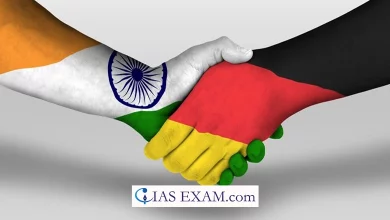Daily Current Affairs for UPSC
Changes in Rules about India’s IP Policy
Syllabus- Science and Technology [GS Paper-3]

Context
India has a new free trade agreement (FTA) called the Trade and Economic Partnership Agreement (TEPA), including rules about intellectual property (IP) and protecting and promoting investments.
Key Highlights
- Recently India has a new free trade agreement (FTA) with Switzerland, Norway, Iceland, and Liechtenstein.
- It is called the Trade and Economic Partnership Agreement (TEPA), and includes rules about intellectual property (IP) and protecting and promoting investments.
- Before this step, India usually discussed IP rules at global meetings like the World Trade Organization (WTO) and didn’t make special IP agreements with other trade groups.
Change in India’s IP Policy
- This change in IP policy isn’t just about the EFTA. India might make similar changes when negotiating with the EU and the UK.
- The idea to change IP and funding rules has been mentioned for a while.
- A paper from August 2022 by Economic Advisory Council to the Prime Minister of India recommended rushing up the patent granting method, taking ideas from the U.S.
- However, this paper failed to deal with the actual motives holding back innovation in India.
- The hints appeared more centered on protecting non-public interest and earning money as opposed to benefiting the public.
- The advisors think that giving IP services will attract foreign funding and help India compete with the U.S. and China in technology.
- The paper also compares the variety of patents filed by China, the U.S., and India to aid its seasoned-patent stance.
- But it overlooked how nations like China, Japan, South Korea, and the U.S. succeeded in technology through state investment and independent innovation.
- Speeding up patents ought to result in lower quality products.
Difference Between India and China w.r.t. IP Rights
- In China, the policy area for indigenous innovation was carried out through programs that run in parallel to maximizing understanding spill overs from FDI.
- This is absent in India and explains why India lags China appreciably in independent innovations.
- China should comprehend its long-term objectives of self-reliance in technological innovation and scientific research as the nation invested in science, technology and innovation (STI).
- STI investments have not coordinated with the creation of IP markets.
Economic Drain from India
- Most of the patents filed in India after the TRIPS settlement were by the foreign companies, displaying that India isn’t always focusing enough on its personal studies and innovation.
- In fact, 80% of tech patents involving Indian inventors are filed by foreign research centres.
- Compared to different top economies, India has one of the lowest numbers of R&D personnel in its industrial sector.
- A large number of Indians, around 40% of the county’s overall R&D workforce, work for American groups in cities like Bangalore, Hyderabad, and the National Capital Region.
- Growing Technology Imports: India is spending more money on importing technologies, while spending on domestic innovation is going down.
- For example, the percentage of spending on home innovation dropped from 13.63% in 2000 to 2.18% in 2018.
- Foreign Companies’ Influence: Companies like Syngenta and Bayer, primarily based in Europe or EFTA countries, are increasing their control over Indian markets through intellectual assets.
- These foreign companies, along with those based in Europe and the U.S., control the rights and royalties from patents advanced with Indian inventors in fields like chemical substances and computers.
- Double Cost for India: Indian society is basically paying two times. First, for teaching and training STEM expertise and then for buying imports, royalties, and costs to overseas agencies that appoint this expertise.
Conclusion
- The new IP and investment rules in trade agreements are leaning closer to the U.S.’s strict IP regulations. This may need to disrupt the stability between public and private interests in India.
- This method might restrict India’s personal improvements and alternatively channel its science and tech skills in the direction of Silicon Valley’s innovation structures.
Source: The Hindu
UPSC Mains Practice Question
Q.Discuss the different forms of intellectual property rights that exist in India. What are the measures that can be taken to further enhance the strength of intellectual property rights? (250 words)





.png)



